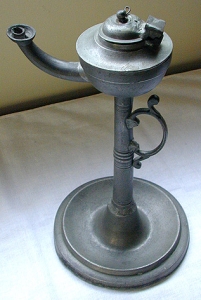|
How the Oil Industry Saved the Whales
A thriving whaling industry developed to provide sperm oil for lighting, and regular whale oil as a lubricant for the machine parts of trains. In the United States alone, the whaling fleet swelled from 392 ships in 1833 to 735 by 1846. At the height of the industry in 1856, sperm oil sold for $1.77 a gallon, and the United States was producing 4 to 5 million gallons of spermaceti and 6 to 10 million gallons of train oil annually. The demand for whale oil took a tremendous toll on whales, and some species were driven to the very brink of extinction. The right whale, one of the scarcer varieties, was killed in the early 1800s at a rate of about 15,000 per year. When the growing scarcity of this whale forced attention to other species, only about 50,000 right whales remained. Had demand for whale oil continued, extinction would have undoubtedly claimed several species. When a clean-burning kerosene lamp invented by Michael Dietz appeared on the market in 1857, its effect on the whaling industry was immediate. Kerosene, known in those days at "Coal Oil", was easy to produce, cheap, smelled better than animal-based fuels when burned, and did not spoil on the shelf as whale oil did. The public abandoned whale oil lamps almost overnight. By 1860, at least 30 kerosene plants were in production in the United States, and whale oil was ultimately driven off the market. When sperm oil dropped to 40 cents a gallon in 1895, due to lack of demand, refined petroleum, which was very much in demand, sold for less than 7 cents a gallon. If petroleum products, such as kerosene and machine oil, had not appeared in the 1850s as alternatives to whale oil, many species of whales would have disappeared long ago. Clearly, the expanding population and economy of the 1800s, together with the development of more deadly hunting tools, would have driven the whaling industry to even greater heights than the banner year of 1856. The September 3, 1860 edition of the "California Fireside Journal" sums up the attitude of the times: "Had it not been for the discovery of Coal Oil, the race of whales would soon have become extinct. It is estimated that ten years would have used up the whole family".
|
|

 Prior to the 1800s, light was provided by torches, candles made from tallow, and lamps which burned oils rendered from animal fat. Because it burned with less odor and smoke than most fuels, whale oil, particularly oil from the nose of the sperm whale, became popular for lamp oils and candles. However, sperm oil, widely known as "spermaceti", was very expensive. In fact, a gallon in the early 1800s cost about $2.00, which in modern values equates to about $200 a gallon. Nonetheless, whale oil was the illuminant of choice for those rich enough to afford it.
Prior to the 1800s, light was provided by torches, candles made from tallow, and lamps which burned oils rendered from animal fat. Because it burned with less odor and smoke than most fuels, whale oil, particularly oil from the nose of the sperm whale, became popular for lamp oils and candles. However, sperm oil, widely known as "spermaceti", was very expensive. In fact, a gallon in the early 1800s cost about $2.00, which in modern values equates to about $200 a gallon. Nonetheless, whale oil was the illuminant of choice for those rich enough to afford it.
